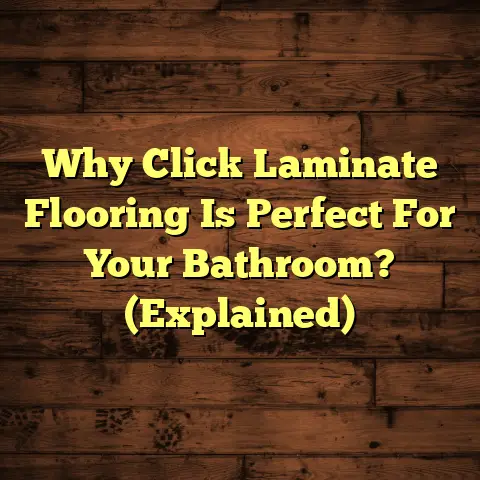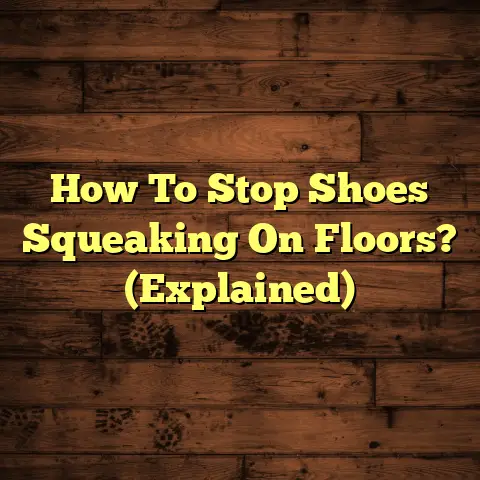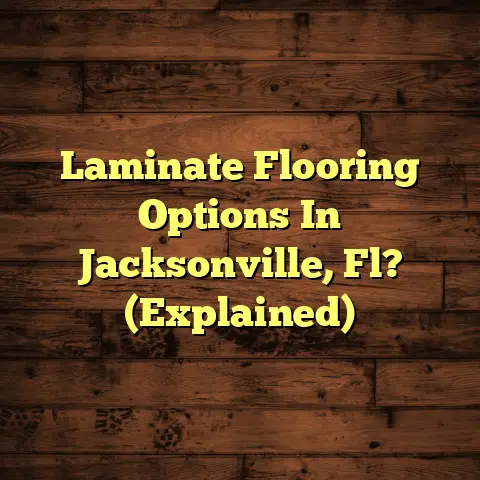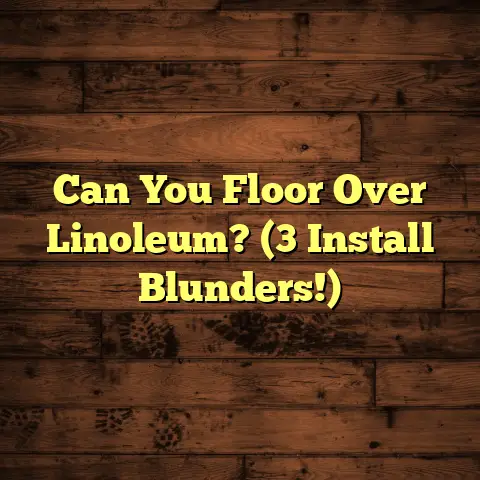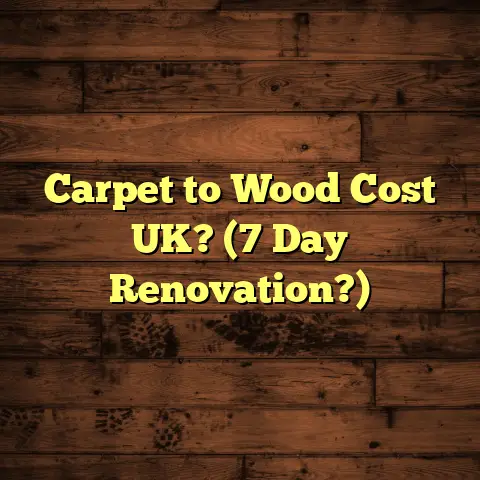Concrete Floor Types? (8 Styles Compared!)
Have you ever walked into a space and just been
completely wowed by the floor?
I have, and
more often than not, it’s been a concrete floor.
But concrete isn’t just that gray, boring slab
you see in warehouses.
Oh no, it’s a chameleon,
capable of transforming into something truly
spectacular.
Let me paint you a picture…
Imagine walking into a sun-drenched living room.
The polished concrete floor gleams warmly,
reflecting the light like a tranquil lake.
Laughter echoes as family gathers, their voices
dancing against the backdrop of this beautifully
designed space.
It feels modern, yet timeless,
inviting you to relax and connect.
Or picture this: a bustling café, alive with the
aroma of coffee and the buzz of conversation.
The stained concrete floor tells a story, a unique
tapestry of color and texture that hints at
creativity and culture.
People linger, drawn in by the ambiance,
savoring not just their drinks but the experience
itself.
That’s the power of concrete!
As a flooring contractor with years of experience,
I’ve seen firsthand how concrete floors can
completely transform a space.
It’s not just
about functionality; it’s about creating an
atmosphere, an emotion.
So, if you’re thinking about new flooring,
stick around.
I’m going to walk you through
eight different concrete floor styles, comparing
their aesthetics, durability, and maintenance.
By the end, you’ll have a clear understanding
of which style is right for you and how to
achieve the concrete floor of your dreams.
Let’s dive in!
1. Polished Concrete
Alright, let’s kick things off with a classic:
polished concrete.
What exactly is polished
concrete?
Well, it’s basically taking an existing or newly
poured concrete slab and grinding it down with
specialized equipment.
Think of it like sanding
wood, but on a much larger and more intense scale.
We use diamond-impregnated pads that get
progressively finer, until we achieve a smooth,
glossy surface.
Sometimes, we’ll even add a
chemical hardener to densify the concrete and
make it even more durable.
Aesthetic Appeal
The beauty of polished concrete lies in its
simplicity and versatility.
That glossy finish
can range from a low sheen to a mirror-like
reflection, depending on the level of polishing.
It’s a fantastic option for modern and
minimalist designs, as it offers a clean,
uncluttered look.
Plus, it reflects light beautifully,
making spaces feel brighter and more open.
You can also customize polished concrete with different aggregates (the stones mixed into the concrete) to create unique visual textures.
I’ve seen floors with everything from small, subtle pebbles to large, dramatic stones, all polished to a stunning shine.
Durability
Now, let’s talk about durability, because polished
concrete is a beast.
Seriously, this stuff can
handle some serious wear and tear.
Because the polishing process hardens and densifies the concrete, it becomes incredibly resistant to scratches, stains, and impacts.
I’ve installed polished concrete in high-traffic areas like retail stores and restaurants, and it holds up beautifully, even after years of heavy use.
In fact, according to a study by the Portland
Cement Association, polished concrete floors can
last for decades with proper maintenance.
(Source: Portland Cement Association)
Maintenance
And speaking of maintenance, that’s another area where polished concrete shines (pun intended!).
It’s incredibly easy to clean – usually just a
quick sweep and damp mop is all you need.
No waxing or special treatments required!
The key is to prevent dirt and grit from scratching
the surface.
Using mats at entryways and cleaning
up spills promptly will go a long way in preserving
the floor’s shine.
I always recommend using a neutral pH cleaner to avoid damaging the polished finish.
2. Stained Concrete
Next up, let’s explore the world of stained
concrete.
This is where things get really
interesting, because you can achieve some
truly stunning and unique looks.
Staining concrete involves applying a chemical solution that reacts with the concrete’s surface, creating a permanent color change.
Unlike paint, which sits on top of the concrete, stain penetrates the surface, resulting in a rich, translucent color that won’t chip or peel.
Aesthetic Appeal
The aesthetic possibilities with stained concrete
are virtually endless.
You can achieve everything
from subtle, earthy tones to bold, vibrant hues.
There are two main types of concrete stains:
acid-based and water-based.
Acid-based stains
create more mottled, variegated looks, while
water-based stains offer a wider range of colors
and more consistent results.
I’ve used staining techniques to create everything
from rustic, Tuscan-inspired floors to sleek,
modern designs.
You can even use stencils or
taping techniques to create intricate patterns and
designs.
Durability
Staining itself doesn’t necessarily increase the concrete’s durability, but it doesn’t compromise it either.
The key to a long-lasting stained concrete floor
is proper sealing.
A good quality sealer will
protect the stained surface from stains, scratches,
and UV damage.
I typically recommend applying several coats of sealer, especially in high-traffic areas.
Maintenance
Maintaining a stained concrete floor is similar
to maintaining polished concrete.
Regular sweeping
and damp mopping are usually sufficient.
Again, it’s important to clean up spills promptly
and use a neutral pH cleaner.
You may need to
reapply the sealer every few years, depending on
the amount of traffic the floor receives.
I like to tell my clients to think of the sealer as a sacrificial layer – it’s designed to protect the stain underneath.
3. Stamped Concrete
Now, let’s talk about stamped concrete.
Have you
ever seen a driveway or patio that looks like
natural stone or brick, but it’s actually concrete?
That’s probably stamped concrete!
This technique
involves pouring concrete and then using stamps
to imprint patterns and textures into the wet
concrete surface.
Aesthetic Appeal
The beauty of stamped concrete is that it allows you to mimic the look of more expensive materials like natural stone, brick, or even wood, at a fraction of the cost.
The range of patterns and textures available is
truly impressive.
You can find stamps that replicate
everything from cobblestone and slate to flagstone
and wood planks.
I’ve used stamped concrete to create stunning outdoor living spaces that seamlessly blend with the surrounding landscape.
Durability
Stamped concrete is quite durable, especially
when properly installed and sealed.
However, it’s
important to understand that it’s not quite as
durable as the materials it mimics.
For example, stamped concrete that looks like natural stone may not hold up as well to extreme weather conditions or heavy traffic as actual natural stone.
That being said, with proper maintenance and sealing, stamped concrete can last for many years.
Maintenance
Maintaining stamped concrete involves regular
cleaning and sealing.
It’s important to remove
any dirt, debris, or mildew that can accumulate
in the textured surface.
I recommend using a pressure washer to clean stamped concrete, but be careful not to use too much pressure, as this can damage the surface.
Sealing is crucial for protecting the stamped
concrete from stains, fading, and cracking.
You’ll typically need to reapply the sealer every
one to three years, depending on the amount of
traffic and exposure to the elements.
4. Exposed Aggregate
Alright, let’s move on to exposed aggregate
concrete.
This style showcases the natural beauty
of the stones and pebbles within the concrete mix.
Instead of having a smooth, uniform surface, exposed aggregate reveals the colorful and textured aggregate beneath.
Description
The process involves pouring concrete with a
carefully selected mix of aggregates.
Once the
concrete has partially set, the surface layer of
cement paste is removed, revealing the aggregate.
This can be done by hand with brushes and water, or with specialized power washing equipment.
Aesthetic Appeal
Exposed aggregate offers a unique and natural
aesthetic.
The different colors, shapes, and
textures of the aggregate create a visually
interesting surface.
It’s a great option for outdoor spaces like patios, walkways, and driveways, as it provides good traction and a slip-resistant surface.
I’ve seen some truly stunning exposed aggregate floors that incorporate unique and colorful stones, creating a one-of-a-kind look.
Durability
Exposed aggregate is known for its durability.
The exposed aggregate provides a tough, abrasion-
resistant surface that can withstand heavy traffic
and harsh weather conditions.
The aggregates themselves are typically very durable, and the concrete matrix provides additional strength and support.
Maintenance
Maintaining exposed aggregate involves regular
cleaning to remove dirt, debris, and mildew.
A pressure washer can be used to clean the
surface, but be careful not to damage the
aggregate.
Sealing is also important to protect the concrete
from stains and fading.
A good quality sealer
will help to enhance the colors of the aggregate
and prevent water from penetrating the surface.
5. Concrete Overlay
Next, let’s talk about concrete overlays.
These
are thin layers of cement-based material that are
applied over existing concrete surfaces.
Think of it like a “facelift” for your old, ugly concrete!
Description
Overlays can be used to repair damaged concrete, cover up unsightly cracks, or create a new decorative surface.
They come in a variety of formulations, including micro-toppings, self-leveling overlays, and stamped overlays.
Aesthetic Appeal
The aesthetic possibilities with concrete overlays
are vast.
You can use them to create a variety
of looks, from smooth and modern to textured and
rustic.
Overlays can be stained, stamped, or stenciled to create custom designs.
I’ve used overlays to transform dull, gray concrete slabs into beautiful, decorative floors that look like natural stone or tile.
Durability
The durability of a concrete overlay depends on the type of overlay used and the quality of the installation.
When properly installed, overlays can significantly
extend the lifespan of existing concrete surfaces.
They can also provide additional protection against
stains, scratches, and UV damage.
Maintenance
Maintaining concrete overlays is similar to
maintaining other types of concrete floors.
Regular cleaning and sealing are essential.
It’s important to use a cleaner that is specifically designed for concrete overlays to avoid damaging the surface.
Sealing should be done every one to three years, depending on the amount of traffic and exposure to the elements.
6. Concrete Tiles
Now, let’s explore concrete tiles.
These are
pre-cast tiles made from concrete that can be
installed like any other type of tile.
Description
Concrete tiles come in a variety of shapes, sizes,
colors, and textures.
They can be used for both
indoor and outdoor applications.
Aesthetic Appeal
The aesthetic appeal of concrete tiles lies in
their versatility.
They can be used to create
a wide range of looks, from modern and minimalist
to rustic and traditional.
Concrete tiles can be patterned, textured, or colored to create unique designs.
I’ve seen some stunning concrete tile floors that mimic the look of natural stone, wood, or even metal.
Durability
Concrete tiles are known for their durability.
They are resistant to scratches, stains, and
impacts.
They are also a good choice for high-traffic areas, as they can withstand heavy use.
Maintenance
Maintaining concrete tiles is relatively easy. Regular sweeping and mopping are usually sufficient.
It’s important to seal concrete tiles to protect them from stains and water damage.
Grout lines should also be sealed to prevent dirt and mildew from accumulating.
7. Self-Leveling Concrete
Alright, let’s talk about self-leveling concrete.
This is a specialized type of concrete that is
designed to flow easily and create a smooth,
level surface.
Description
Self-leveling concrete is typically used to create a new floor surface over an existing concrete slab that is uneven or damaged.
It can also be used to create a seamless, industrial-style floor.
Aesthetic Appeal
The aesthetic appeal of self-leveling concrete
lies in its smooth, seamless finish.
It creates
a clean, modern look that is perfect for
contemporary spaces.
Self-leveling concrete can be stained, dyed, or polished to create custom designs.
Durability
Self-leveling concrete is quite durable, especially
when properly installed and sealed.
It’s resistant
to cracking and deformation.
Maintenance
Maintaining self-leveling concrete is similar to
maintaining other types of concrete floors.
Regular sweeping and mopping are usually sufficient.
It’s important to seal self-leveling concrete to protect it from stains and water damage.
8. Colored Concrete
Finally, let’s explore colored concrete.
This is
concrete that has been mixed with pigments or dyes
to create a specific color.
Description
Colored concrete can be used for a variety of applications, including floors, patios, and driveways.
Aesthetic Appeal
The aesthetic appeal of colored concrete lies in its ability to add vibrancy and personality to a space.
You can choose from a wide range of colors to create the perfect look for your home or business.
Durability
The durability of colored concrete is similar to
that of regular concrete.
However, it’s important
to use high-quality pigments or dyes that are
resistant to fading.
Maintenance
Maintaining colored concrete involves regular
cleaning and sealing.
It’s important to use a
sealer that is specifically designed for colored
concrete to protect the color from fading.
Conclusion
Wow, we’ve covered a lot of ground!
From the
sleek elegance of polished concrete to the rustic
charm of exposed aggregate, we’ve explored eight
different concrete floor styles, each with its
own unique aesthetic, durability, and maintenance
requirements.
Think back to that sun-drenched living room with
the gleaming polished concrete floor.
Or the
bustling café with the stained concrete that
tells a story.
Each of these styles has the power to transform a space, to evoke a feeling, to create an experience.
Choosing the right concrete floor style for your
home or business is a personal decision.
Consider
your needs, your style preferences, and the
specific environment where the floor will be
installed.
Do you need a durable, low-maintenance floor for
a high-traffic area?
Polished concrete or exposed
aggregate might be a good choice.
Are you looking to create a unique and artistic
statement?
Stained concrete or stamped concrete
could be the answer.
Do you need to cover up an existing, damaged
concrete slab?
A concrete overlay might be the
perfect solution.
No matter which style you choose, remember that concrete flooring is an investment that can add value and beauty to your space for years to come.
It’s a durable, versatile, and sustainable material that offers endless possibilities for design and expression.
So, go ahead, envision the possibilities!
Imagine
the concrete floor of your dreams, and then
make it a reality.
You won’t be disappointed.
